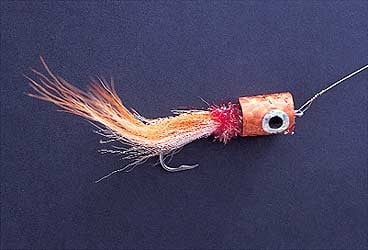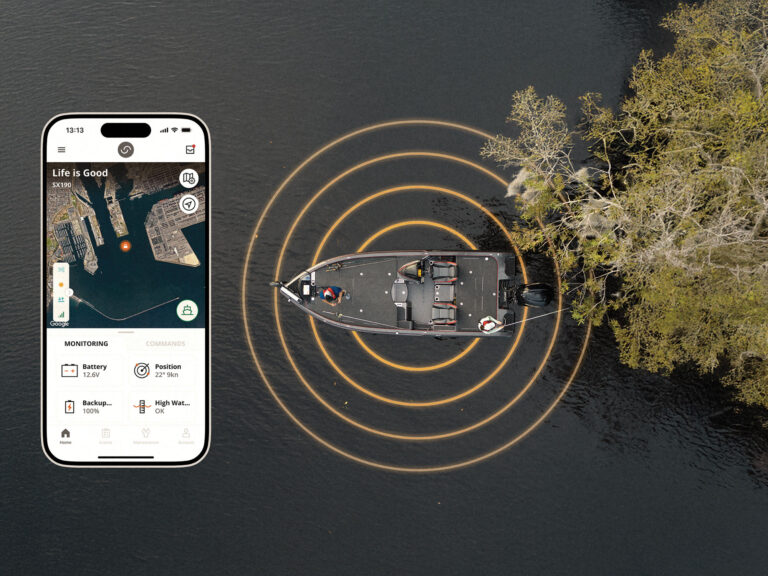
I got my first significant lesson on the effectiveness of poppers in Baja California, where we targeted a variety of offshore species. Unlike Florida, Baja anglers do not speak in terms of grand slams. Yet on that trip, I like to think I scored a south-of-the-border version when I caught a sailfish, roosterfish and scores of dorado all in one day while fishing out of Rancho Buena Vista on the East Cape. And I caught them all on Bob’s Bangers, an improved popper design perfected by Bob Popovics.
In addition to the large profile made possible by its cylindrical shape, the flat-faced, centerline configuration of the Banger is a definite improvement over the traditional slant- or cup-faced popper. Taking a cue from offshore trolling lures, Popovics modified the standard popper by inserting the hook eye dead center in the flat-face body. This makes it possible to create maximum surface disturbance with a minimum of forward movement.
Eligible Species
The Banger’s centerline construction makes it a natural for sailfish, which sometimes prove lethargic even after they’ve been teased close to the boat. With the Banger configuration in white, red, yellow or even black, the offering becomes easy pickings. All you have to do is pop it a couple of times across a few feet of water – the action is loud and visible. And if the Banger is in close proximity to a sailfish that is wondering what happened to its meal, the reaction is often a very determined attempt to engulf that which it perceives to be noisy prey struggling on the surface.
Dorado are sometimes referred to as “Baja Gold,” for a number of reasons – their beautiful coloration, their abundance in the region, and perhaps most important of all, their readiness to strike practically anything you put in front of them. Without a doubt, in the Baja they are generally the fly fisher’s most readily available quarry. However, this doesn’t mean they always strike any fly with abandon. e witnessed numerous occasions when they would readily eat the chum but stubbornly refuse all artificials. At times like these, we found the Banger to be my best choice and I use one of two methods to draw strikes.
First, I try casting the Banger at a cruising fish, popping it a few times and then taking it off the water. I do this several times until I feel I have the dorado aroused. Then I cast it again, pop it several times and let it rest on the surface motionless. Sometimes they hit it while popping it, but most often they’ll hit best when the fly lies at rest on the surface.
The second tactic I learned from Popovics. If the standard chugging action fails to draw any strikes, he will quickly pull the Banger sharply through the water. This can be difficult to effect with a slant-faced popper because it has a tendency to twist and turn. A Banger, however, will respond just like a high-speed trolling lure. When pulled forward rapidly, it will track straight and produce a trail of bubbles. With a fly rod, you can only pull the Banger a few feet, but often this is all it takes to trigger a fish’s attack mechanism.
For me, the most significant confirmation of the Banger’s effectiveness was its taking of a roosterfish -considered to be the Baja equivalent of permit by those who have caught both species. Roosters can be very difficult fish to entice with a fly, even when teased close with plugs or even live bait, yet my trusty Banger’s -the same size I had used to catch a 70-pound sailfish that morning -caught the first rooster we made a cast to. The live mullet teaser that raised the fish obviously helped in the game, as did an accurate cast, but convinced the magnitude of the noise and surface commotion created by the Banger was instrumental in piquing the rooster’s initial arousal.
Popovics originally designed the Banger for bluefish and striped bass for his home waters in New Jersey. Now that I make my home in Connecticut and have the opportunity to fish much of the northeast on a regular basis, I can attest to the Banger’s effectiveness on both species. It’s an absolute natural for voracious bluefish that seem to have a penchant for striking anything foundering on the surface. And for shallow-water striped bass, the surface takes are so dramatic that grown men whoop it up like school kids being awarded extra vacation time.
Using the Banger
In terms of casting ease, the Banger is an improvement over the slant-faced popper. Because the flat-face profile yields a maximum of commotion when popped along the surface, the length of the Banger’s foam body can be shortened to half that of a standard popper with no compromise in performance. This reduces bulk and weight, making casts easier. To further facilitate casting, I keep the leader short and simple by connecting a 2 1/2-foot butt section of 40- or 50-pound mono to the same length class tippet, usually 20-pound test. The heavy butt section helps turn the Banger over on the cast, and makes it easier to grab the leader when landing a fish.
I like to rig the Banger similarly to big-game trolling lures, in that I run the tippet through the center of the foam body. Simply punch a hole through the foam with a small-diameter nail or large sewing needle. To form the hole directly down the centerline, heat the needle and then rotate both it and the foam body as you work the needle through. Some tiers like to insert a small section of plastic tubing into the hole, but this isn’t necessary.
You can purchase the cylindrical foam bodies in most fly tackle stores. They are available in different diameters that can be tailored to the species and the size of the outfit you’ll be fishing. For example, a 9-weight rod should easily handle a half-inch-long, penny-size diameter foam body. Water conditions will also dictate the size of the Banger you should use. In very calm water you can opt for smaller-diameter Bangers, but keep in mind that considerable surface chop will require a larger head.
As a variation on Bob’s original design, for the business end of the Banger I like to use simple streamer patterns like a Deceiver tied on a long-shank hook such as a Wright and McGill 66SS. This particular hook is offset but can be easily straightened with a pair of pliers. Tied in this fashion, any number of streamers can be quickly inserted into different foam heads. One minute you can be fishing a streamer and in a matter of seconds make the conversion to a popper.
The Banger is certainly not the “be all, end all” for every surface application. But under those circumstances when you want to get a fish’s attention with a water-churning offering, the Banger remains my first choice. Fish it and you’ll be hard-pressed to top the sheer drama and excitement of the experience.









